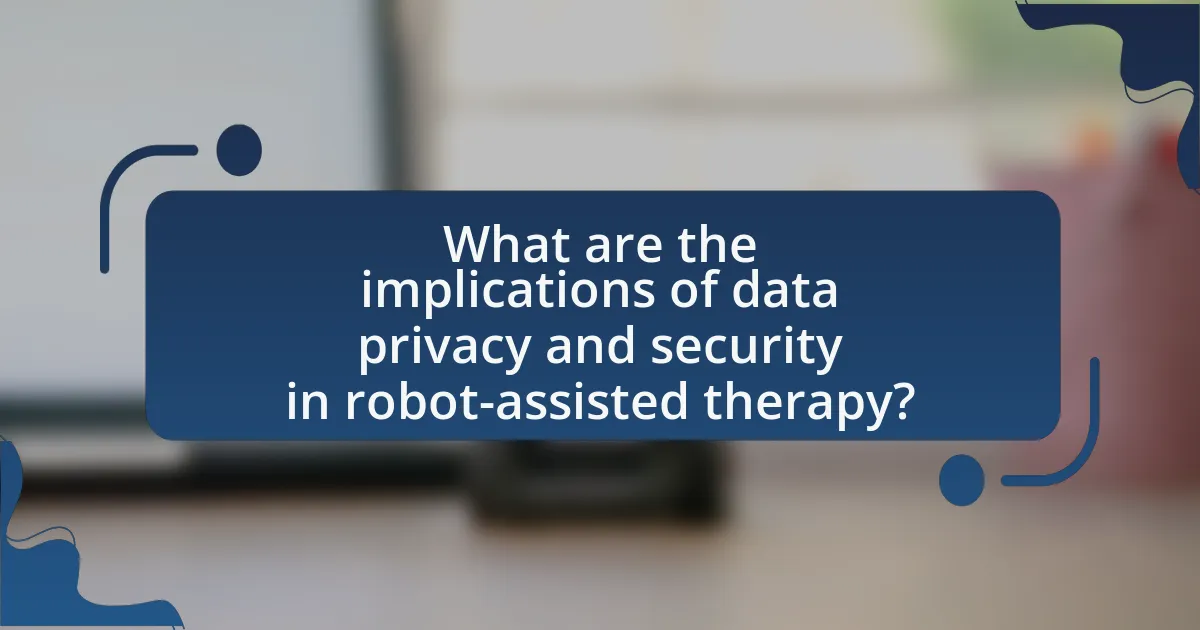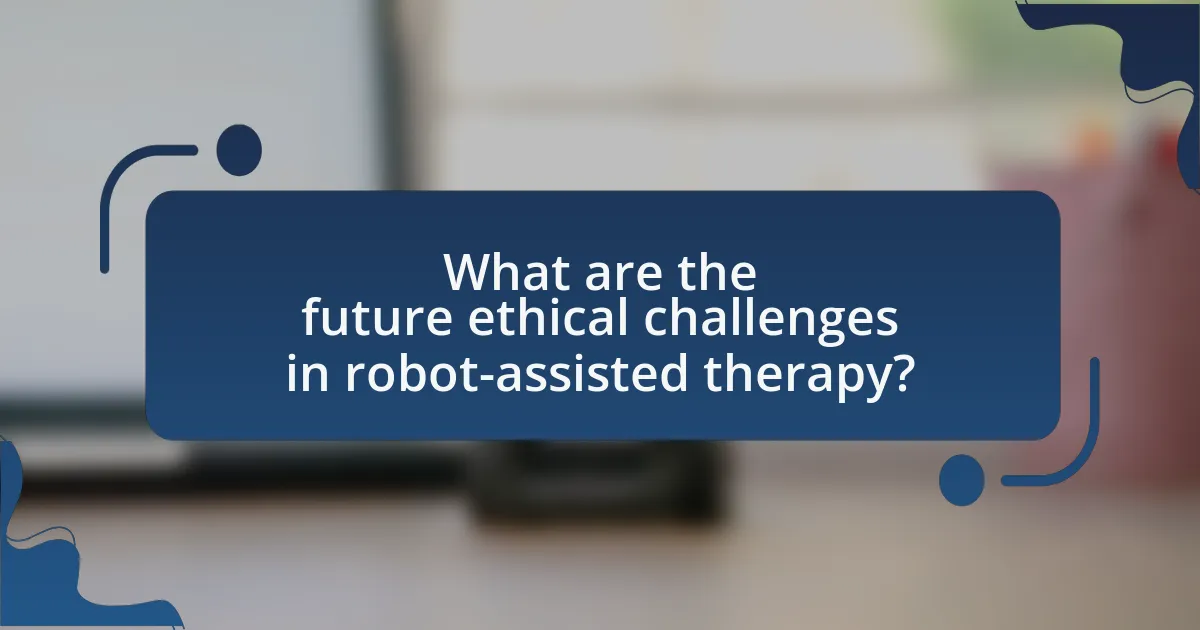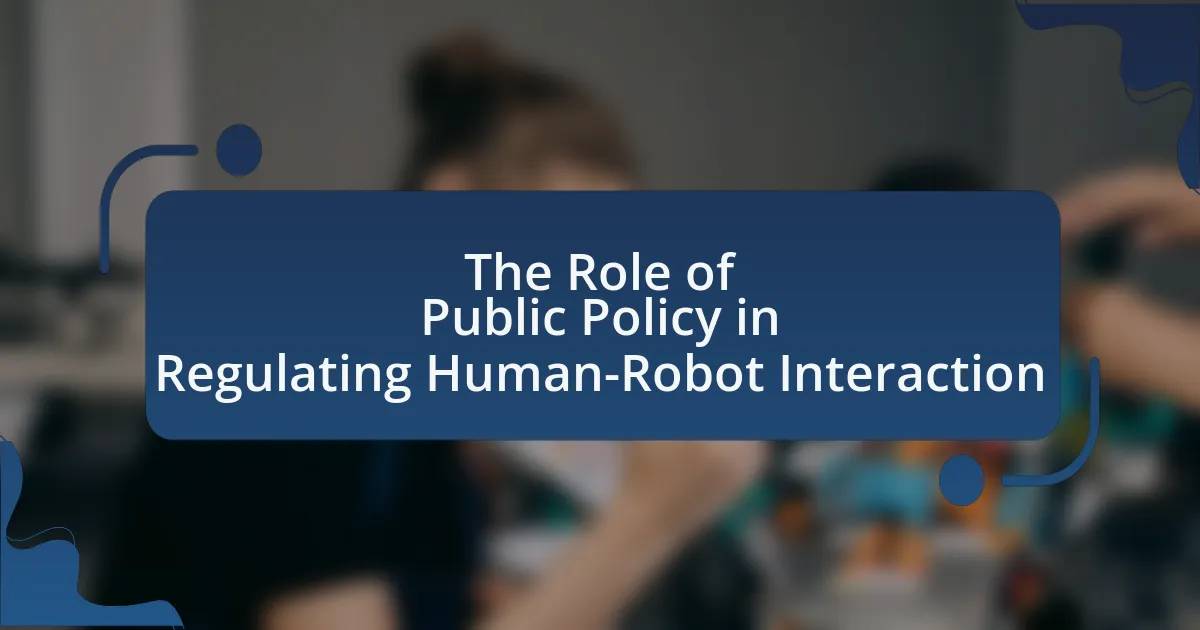The article focuses on the ethical considerations in robot-assisted therapy, highlighting key issues such as patient autonomy, informed consent, data privacy, and the potential for emotional attachment to robotic systems. It emphasizes the importance of ethical principles like beneficence, non-maleficence, and justice in ensuring patient welfare and safety. The article also addresses potential ethical dilemmas, including the quality of human interaction and the implications of cultural perspectives on therapy. Furthermore, it discusses the legal frameworks governing the ethical use of robots in therapy and outlines best practices for maintaining ethical compliance in this evolving field.

What are the Ethical Considerations in Robot-Assisted Therapy?
Ethical considerations in robot-assisted therapy include issues of patient autonomy, informed consent, data privacy, and the potential for emotional attachment to robots. Patient autonomy is crucial, as individuals must have the right to choose or refuse robot-assisted therapy. Informed consent is necessary to ensure that patients understand the capabilities and limitations of robotic systems. Data privacy concerns arise from the collection and storage of sensitive patient information by robotic systems, necessitating strict adherence to confidentiality standards. Additionally, the risk of emotional attachment to robots can complicate therapeutic relationships, potentially affecting the patient’s emotional well-being and treatment outcomes. These considerations are supported by research indicating that ethical frameworks must evolve alongside technological advancements in healthcare to safeguard patient rights and welfare.
Why is ethics important in the context of robot-assisted therapy?
Ethics is crucial in robot-assisted therapy because it ensures the safety, dignity, and autonomy of patients. Ethical considerations guide the development and implementation of robotic systems, addressing potential risks such as privacy violations, dependency on technology, and the need for informed consent. For instance, the American Psychological Association emphasizes the importance of ethical standards in maintaining patient welfare and confidentiality, which are vital in therapeutic settings. By adhering to ethical principles, practitioners can foster trust and promote positive therapeutic outcomes while minimizing harm.
What ethical principles are commonly applied in healthcare?
The ethical principles commonly applied in healthcare include autonomy, beneficence, non-maleficence, and justice. Autonomy emphasizes the patient’s right to make informed decisions about their own care, while beneficence focuses on actions that promote the well-being of patients. Non-maleficence requires healthcare providers to avoid causing harm, and justice pertains to the fair distribution of healthcare resources and treatment. These principles guide healthcare professionals in making ethical decisions and ensuring patient rights are respected.
How do these principles relate to robot-assisted therapy?
The principles of ethical considerations in robot-assisted therapy emphasize the importance of patient autonomy, beneficence, non-maleficence, and justice. These principles relate directly to robot-assisted therapy by ensuring that the technology is used to enhance patient care while respecting individual rights and promoting well-being. For instance, patient autonomy is upheld by involving patients in decision-making about their therapy, while beneficence and non-maleficence guide the design and implementation of robotic systems to maximize benefits and minimize harm. Additionally, justice ensures equitable access to robot-assisted therapy across diverse populations, addressing disparities in healthcare. These ethical principles are foundational for developing guidelines and standards that govern the use of robots in therapeutic settings, ensuring that they serve the best interests of patients.
What are the potential ethical dilemmas in robot-assisted therapy?
Potential ethical dilemmas in robot-assisted therapy include issues of patient autonomy, data privacy, and the quality of human interaction. Patient autonomy may be compromised if individuals feel pressured to accept robotic assistance over traditional therapy methods. Data privacy concerns arise from the collection and storage of sensitive patient information by robotic systems, which could be vulnerable to breaches. Additionally, the quality of human interaction may diminish, as reliance on robots could lead to reduced emotional support and empathy that human therapists provide, potentially impacting therapeutic outcomes. These dilemmas highlight the need for careful consideration of ethical standards in the implementation of robot-assisted therapy.
How does patient autonomy play a role in robot-assisted therapy?
Patient autonomy is crucial in robot-assisted therapy as it empowers individuals to make informed decisions about their treatment options. This autonomy ensures that patients actively participate in their care, which can enhance their engagement and satisfaction with the therapeutic process. Research indicates that when patients are involved in decision-making, they are more likely to adhere to treatment plans and experience better health outcomes. For instance, a study published in the Journal of Medical Ethics highlights that respecting patient autonomy in robotic interventions leads to improved psychological well-being and trust in healthcare providers. Thus, patient autonomy not only fosters a collaborative therapeutic environment but also aligns with ethical principles in healthcare.
What are the implications of informed consent in this context?
Informed consent in the context of robot-assisted therapy implies that patients must be fully aware of the nature, risks, and benefits of the therapy involving robotic systems. This requirement ensures that patients can make autonomous decisions regarding their treatment, which is a fundamental ethical principle in healthcare. The implications include the necessity for clear communication from healthcare providers about how robots will be used, the potential for data privacy concerns, and the need for ongoing consent as therapy progresses. Research indicates that informed consent enhances patient trust and engagement, which are critical for effective therapeutic outcomes in robot-assisted interventions.
How do cultural perspectives influence ethical considerations in robot-assisted therapy?
Cultural perspectives significantly influence ethical considerations in robot-assisted therapy by shaping beliefs about autonomy, consent, and the role of technology in healthcare. For instance, in collectivist cultures, the emphasis on community and family may lead to different expectations regarding the involvement of robots in therapy, prioritizing group consent over individual autonomy. Research indicates that cultural values can dictate how patients perceive the efficacy and appropriateness of robotic interventions, affecting their willingness to engage with such technologies. Additionally, ethical frameworks may vary; cultures that prioritize traditional healing practices might view robot-assisted therapy with skepticism, raising concerns about the loss of human touch in care. This highlights the necessity for culturally sensitive approaches in the development and implementation of robot-assisted therapies to ensure ethical alignment with diverse patient values and expectations.
What cultural factors must be considered when implementing robot-assisted therapy?
Cultural factors that must be considered when implementing robot-assisted therapy include beliefs about technology, attitudes toward mental health treatment, and the role of family in care decisions. Different cultures may have varying levels of acceptance regarding the use of robots in therapeutic settings, which can influence patient engagement and outcomes. For instance, in cultures that prioritize human interaction in therapy, patients may be less receptive to robot-assisted methods. Additionally, cultural perceptions of mental health can affect how individuals view the need for therapy and the appropriateness of using technology in that context. Family dynamics also play a crucial role, as some cultures may involve family members in decision-making processes regarding treatment, impacting the acceptance of robot-assisted therapy. Understanding these cultural nuances is essential for effective implementation and to ensure that therapy aligns with the values and expectations of the patients and their families.
How do different cultures perceive the use of robots in therapeutic settings?
Different cultures perceive the use of robots in therapeutic settings with varying degrees of acceptance and skepticism. For instance, in Japan, there is a generally positive attitude towards robots in healthcare, influenced by cultural values that embrace technology and innovation, as evidenced by the integration of robotic companions in elder care facilities. Conversely, in Western cultures, such as the United States, there is a more cautious approach, often rooted in concerns about emotional detachment and ethical implications, as highlighted by studies indicating that many individuals prefer human interaction over robotic assistance in therapy. These cultural perceptions are shaped by historical context, societal values, and individual experiences with technology, leading to diverse attitudes towards the role of robots in therapeutic environments.

What are the implications of data privacy and security in robot-assisted therapy?
Data privacy and security in robot-assisted therapy are critical due to the sensitive nature of personal health information involved. The integration of robots in therapeutic settings often requires the collection, storage, and transmission of patient data, which can expose individuals to risks of data breaches and unauthorized access. For instance, a study published in the Journal of Medical Internet Research highlights that 60% of healthcare organizations experienced a data breach in recent years, underscoring the vulnerability of health data. Furthermore, compliance with regulations such as HIPAA in the United States mandates strict safeguards for patient information, necessitating robust security measures in robot-assisted therapy systems to protect against potential misuse.
How is patient data handled in robot-assisted therapy?
Patient data in robot-assisted therapy is handled with strict adherence to privacy regulations and ethical guidelines. Healthcare providers ensure that patient information is collected, stored, and transmitted securely, often utilizing encryption and access controls to protect sensitive data. Compliance with regulations such as the Health Insurance Portability and Accountability Act (HIPAA) in the United States mandates that patient data is kept confidential and only accessible to authorized personnel. Additionally, informed consent is obtained from patients, ensuring they understand how their data will be used in the context of therapy. This approach not only safeguards patient privacy but also fosters trust in the therapeutic process.
What are the risks associated with data breaches in this field?
Data breaches in robot-assisted therapy pose significant risks, including unauthorized access to sensitive patient data, which can lead to identity theft and privacy violations. The healthcare sector, particularly in therapy involving robots, is subject to strict regulations like HIPAA, which mandates the protection of patient information. Breaches can result in financial penalties for organizations, loss of patient trust, and potential legal repercussions. For instance, a 2020 report by IBM found that the average cost of a healthcare data breach was $7.13 million, highlighting the financial impact of such incidents. Additionally, compromised data can undermine the therapeutic relationship, as patients may feel less secure sharing personal information, ultimately affecting treatment outcomes.
How can patient confidentiality be maintained in robot-assisted therapy?
Patient confidentiality in robot-assisted therapy can be maintained through robust data encryption, secure communication protocols, and strict access controls. These measures ensure that sensitive patient information is protected from unauthorized access during therapy sessions. For instance, implementing end-to-end encryption for data transmitted between the robot and healthcare providers prevents interception by third parties. Additionally, using secure servers and limiting access to authorized personnel only further safeguards patient data. Research indicates that adherence to these security protocols significantly reduces the risk of data breaches, thereby enhancing patient trust and compliance in robot-assisted therapy settings.
What regulations govern the ethical use of robots in therapy?
The ethical use of robots in therapy is governed by regulations such as the Health Insurance Portability and Accountability Act (HIPAA) in the United States, which ensures patient privacy and data security. Additionally, the American Psychological Association (APA) provides guidelines for the ethical practice of psychology, which include considerations for the use of technology in therapeutic settings. These regulations are designed to protect patient welfare, ensure informed consent, and promote the responsible integration of robotic technologies in therapeutic practices.
What are the key legal frameworks affecting robot-assisted therapy?
The key legal frameworks affecting robot-assisted therapy include medical device regulations, data protection laws, and liability frameworks. Medical device regulations, such as those enforced by the U.S. Food and Drug Administration (FDA) and the European Medicines Agency (EMA), govern the approval and use of robotic systems in clinical settings, ensuring safety and efficacy. Data protection laws, like the General Data Protection Regulation (GDPR) in Europe, regulate how patient data is collected, stored, and used, emphasizing patient privacy and consent. Liability frameworks address accountability in cases of malfunction or harm caused by robotic systems, determining who is responsible—manufacturers, healthcare providers, or software developers—when issues arise. These legal frameworks collectively shape the operational landscape for robot-assisted therapy, ensuring compliance and safeguarding patient rights.
How do these regulations ensure ethical practices?
Regulations ensure ethical practices in robot-assisted therapy by establishing clear guidelines that govern the development, deployment, and use of robotic systems in therapeutic settings. These guidelines mandate adherence to safety standards, informed consent, and the protection of patient privacy, which collectively foster trust and accountability in therapeutic interactions. For instance, the American Psychological Association emphasizes the necessity of informed consent, ensuring that patients understand the role of robots in their therapy, thereby promoting transparency and ethical engagement. Additionally, regulations often require regular assessments of robotic systems to ensure they meet ethical standards, thus safeguarding patient welfare and enhancing the overall integrity of therapeutic practices.

What are the future ethical challenges in robot-assisted therapy?
Future ethical challenges in robot-assisted therapy include issues of patient privacy, informed consent, and the potential for dependency on robotic systems. As these therapies become more integrated into healthcare, safeguarding patient data becomes critical, especially given the sensitive nature of health information. Informed consent is also a concern, as patients must fully understand the capabilities and limitations of robotic systems, which may not be straightforward. Additionally, there is a risk that patients may develop a reliance on robotic assistance, potentially undermining their autonomy and ability to engage in traditional therapeutic practices. These challenges necessitate ongoing ethical scrutiny and the development of guidelines to ensure responsible implementation of robot-assisted therapy.
How might advancements in technology impact ethical considerations?
Advancements in technology significantly impact ethical considerations by introducing new dilemmas related to privacy, autonomy, and accountability. For instance, the integration of artificial intelligence in robot-assisted therapy raises questions about patient data security and informed consent, as sensitive health information may be collected and analyzed without explicit permission. Research by the American Psychological Association highlights that the use of robots in therapeutic settings can lead to ethical concerns regarding the emotional attachment patients may develop towards machines, potentially undermining human relationships and care. Furthermore, the delegation of therapeutic roles to robots necessitates clear guidelines on accountability, particularly in cases where a robot’s actions may lead to harm or misdiagnosis. These advancements compel stakeholders to continuously evaluate and adapt ethical frameworks to ensure that technology enhances rather than compromises patient welfare.
What new ethical dilemmas could arise with AI integration in therapy?
AI integration in therapy could lead to ethical dilemmas such as confidentiality breaches, informed consent issues, and the potential for biased algorithms affecting treatment outcomes. The use of AI may compromise patient privacy if sensitive data is not adequately protected, as evidenced by incidents where data breaches have occurred in healthcare settings. Additionally, patients may not fully understand the role of AI in their therapy, raising concerns about whether they can give informed consent. Research indicates that algorithms can perpetuate existing biases, which could result in unequal treatment for different demographic groups, as highlighted in studies examining algorithmic bias in healthcare.
How can stakeholders prepare for future ethical challenges?
Stakeholders can prepare for future ethical challenges in robot-assisted therapy by establishing comprehensive ethical guidelines and frameworks. These guidelines should address issues such as patient consent, data privacy, and the potential for bias in algorithms. Research indicates that proactive engagement with ethical considerations can mitigate risks; for instance, a study by Lin et al. (2017) emphasizes the importance of integrating ethical training for developers and practitioners to enhance decision-making in technology deployment. By fostering a culture of ethical awareness and continuous dialogue among stakeholders, including healthcare providers, technologists, and ethicists, the potential for ethical dilemmas can be significantly reduced.
What best practices can be adopted to address ethical concerns in robot-assisted therapy?
To address ethical concerns in robot-assisted therapy, best practices include ensuring informed consent, maintaining patient privacy, and implementing rigorous safety protocols. Informed consent requires that patients fully understand the role of robots in their therapy, including potential risks and benefits, which is essential for ethical transparency. Maintaining patient privacy involves safeguarding sensitive data collected during therapy sessions, adhering to regulations such as HIPAA, which mandates the protection of health information. Implementing rigorous safety protocols ensures that robots are regularly tested and monitored for malfunctions, thereby minimizing risks to patients. These practices are supported by research indicating that ethical frameworks enhance patient trust and therapy outcomes, as highlighted in studies on the integration of technology in healthcare settings.
How can practitioners ensure ethical compliance in their practices?
Practitioners can ensure ethical compliance in their practices by adhering to established ethical guidelines and frameworks specific to robot-assisted therapy. This includes obtaining informed consent from patients, ensuring confidentiality, and conducting regular ethical training sessions for staff. Research indicates that adherence to ethical standards, such as those outlined by the American Psychological Association, significantly enhances patient trust and safety in therapeutic settings. Furthermore, implementing a system for reporting ethical concerns and conducting regular audits can help maintain compliance and address any potential ethical dilemmas proactively.
What role do training and education play in promoting ethical standards?
Training and education are essential in promoting ethical standards by equipping individuals with the knowledge and skills necessary to understand and apply ethical principles in their professional practices. Specifically, structured training programs can enhance awareness of ethical dilemmas and foster critical thinking, enabling practitioners to navigate complex situations effectively. For instance, research indicates that healthcare professionals who undergo ethics training demonstrate improved decision-making and adherence to ethical guidelines, as evidenced by a study published in the Journal of Medical Ethics, which found that 75% of participants reported increased confidence in addressing ethical issues after completing an ethics education program. This correlation underscores the significant impact that targeted training and education have on reinforcing ethical standards within fields such as robot-assisted therapy.





